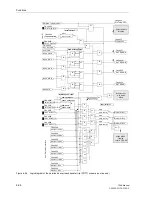
Functions
6-90
7SA6 Manual
C53000-G1176-C156-2
Signal
Transmission
Channels
The pilot wire comparison, that is exclusively applied to short tie lines, enables the
user to operate a pilot wire pair (pilot wires or control wires) with direct current to guar-
antee the exchange of information between the line ends. Also the reverse interlocking
operates with DC control signals.
For the other schemes at least one communication channel in each direction is re-
quired. For example, fibre optic connections or voice frequency modulated high fre-
quency channels via pilot cables, power line carrier or microwave radio links can be
used for this purpose.
If the device is equipped with an optional protection data interface, digital
communication channels can be used for signal transfer; these include: Fibre optic
cables, communication networks or pilot wires. The following signal transmission
schemes are suited for these kinds of transmission:
Permissive Underreach Transfer Trip with Zone Acceleration Z1B (PUTT),
Permissive Overreach Transfer Trip (POTT) (with overreaching zone Z1B).
The 7SA6 also makes provision for the transmission of phase segregated signals. For
this purpose, three transmission channels are required in each direction. The
additional expense for the signal transmission is weighed up by the advantage that
dependable single-pole automatic reclosure can be carried out even when two single-
phase faults occur on different lines in the system. Where the digital protection data
interface is used, the signal transmission is always phase segregated.
The signal transmission schemes are also suited to three terminal lines (teed feeders).
In this case, signal transmission channels are required from each of the three ends to
the each of the others in both directions. Phase segregated transmission is only pos-
sible for three terminal line applications if digital communication channels are used.
During disturbances in the receiver or in the transmission path, the teleprotection
supplement may be blocked via a binary input, without affecting the normal time
graded distance protection. The measuring reach control (enable zone Z1B) can be
obtained via the binary input “
>Enable ARzones
” (see also Figure 6-38 above) from
an external reclosure device or from the internal automatic reclose function. With
conventional signal transmission schemes, the disturbance is signalled by a binary
input, with digital communication it is detected automatically by the protection device.
6.6.1
Method of Operation
Switching
On and Off
The teleprotection function can be switched on and off by means of the parameter
2101
FCT Telep. E/F
, or via the system interface (if available) and via binary input
(if this is allocated). The switched state is saved internally (refer to Figure 6-49) and
secured against loss of auxiliary supply. It is only possible to switch on from the source
where previously it had been switched off from. To be active, it is necessary that the
function is switched on from all three switching sources.
Содержание siprotec 7SA6
Страница 2: ...Siemens Aktiengesellschaft Book No C53000 G1176 C156 2 ...
Страница 18: ...xviii 7SA6 Manual C53000 G1176 C156 2 ...
Страница 32: ...Introduction 1 14 7SA6 Manual C53000 G1176 C156 2 ...
Страница 82: ...Hardware and Connections 2 50 7SA6 Manual C53000 G1176 C156 2 ...
Страница 119: ...SIPROTEC 4 Devices 4 25 7SA6 Manual C53000 G1176 C156 2 Figure 4 20 CFC Logic example ...
Страница 190: ...Configuration 5 62 7SA6 Manual C53000 G1176 C156 2 ...
Страница 559: ...Control During Operation 7 45 7SA6 Manual C53000 G1176 C156 2 Figure 7 45 Circuit breaker trip test in DIGSI 4 ...
Страница 652: ...Installation and Commissioning 8 78 7SA6 Manual C53000 G1176 C156 2 ...
Страница 724: ...Technical Data 10 56 7SA6 Manual C53000 G1176 C156 ...
Страница 800: ...Appendix A 76 7SA6 Manual C53000 G1176 C156 2 ...
Страница 866: ...Appendix B 66 7SA6 Manual C53000 G1176 C156 2 ...















































